Financial Decision Making: Analyzing Panini Ltd's Financial Ratios
VerifiedAdded on 2023/06/11
|12
|3385
|140
Report
AI Summary
This report delves into financial decision-making, focusing on the roles and responsibilities of the accounting and finance departments within Panini Ltd. It identifies key functions of both departments, including financial and management accounting, investment strategies, working capital management, and sources of finance. The report further calculates and analyzes financial ratios such as gross profit margin, operating profit margin, ROCE, and current ratio for the years 2018 and 2019, providing insights into the company's performance and offering recommendations for future improvement. This analysis aids in understanding the financial health and strategic direction of Panini Ltd, offering valuable insights for informed decision-making.

Financial Decision
Making
Making
Paraphrase This Document
Need a fresh take? Get an instant paraphrase of this document with our AI Paraphraser
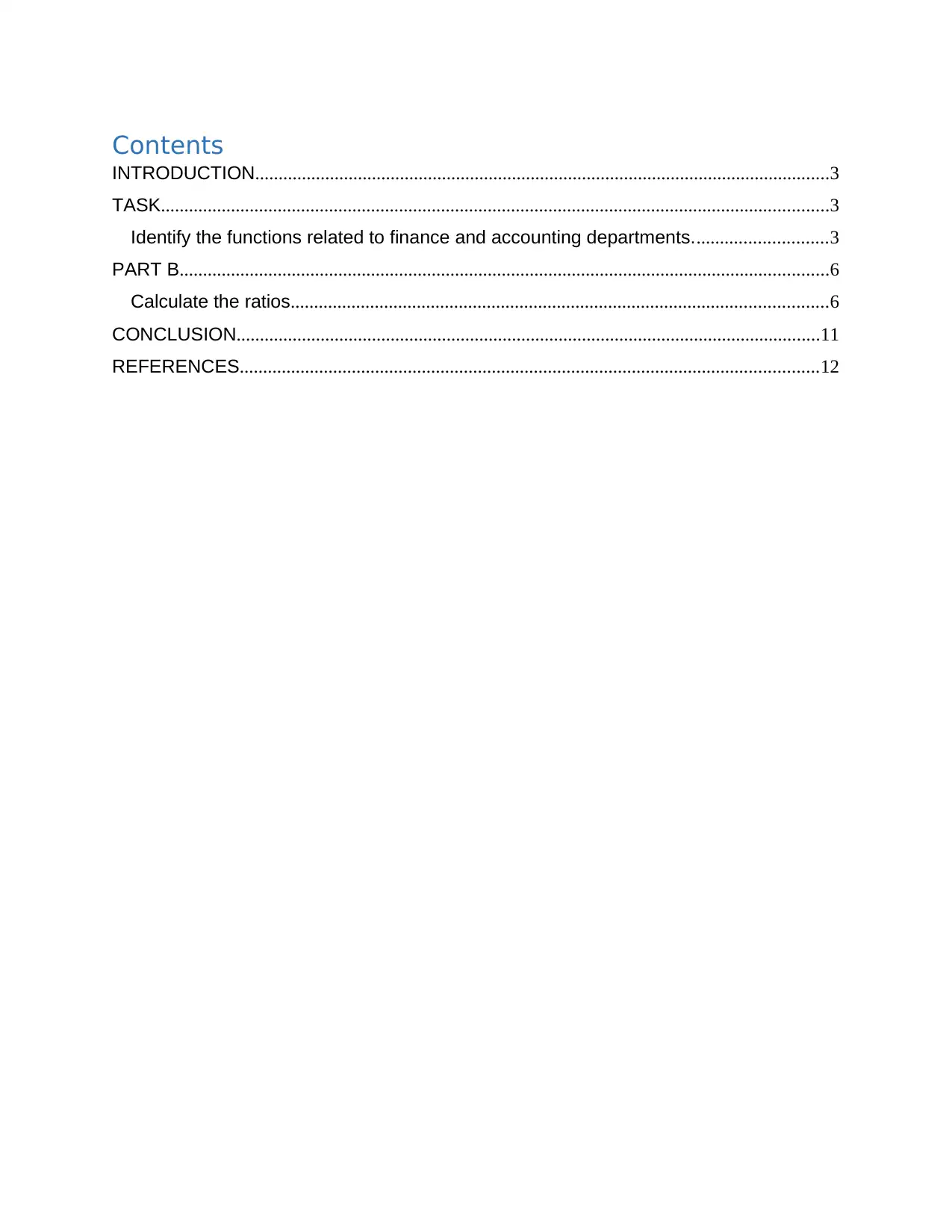
Contents
INTRODUCTION...........................................................................................................................3
TASK...............................................................................................................................................3
Identify the functions related to finance and accounting departments.............................3
PART B...........................................................................................................................................6
Calculate the ratios...................................................................................................................6
CONCLUSION.............................................................................................................................11
REFERENCES............................................................................................................................12
INTRODUCTION...........................................................................................................................3
TASK...............................................................................................................................................3
Identify the functions related to finance and accounting departments.............................3
PART B...........................................................................................................................................6
Calculate the ratios...................................................................................................................6
CONCLUSION.............................................................................................................................11
REFERENCES............................................................................................................................12
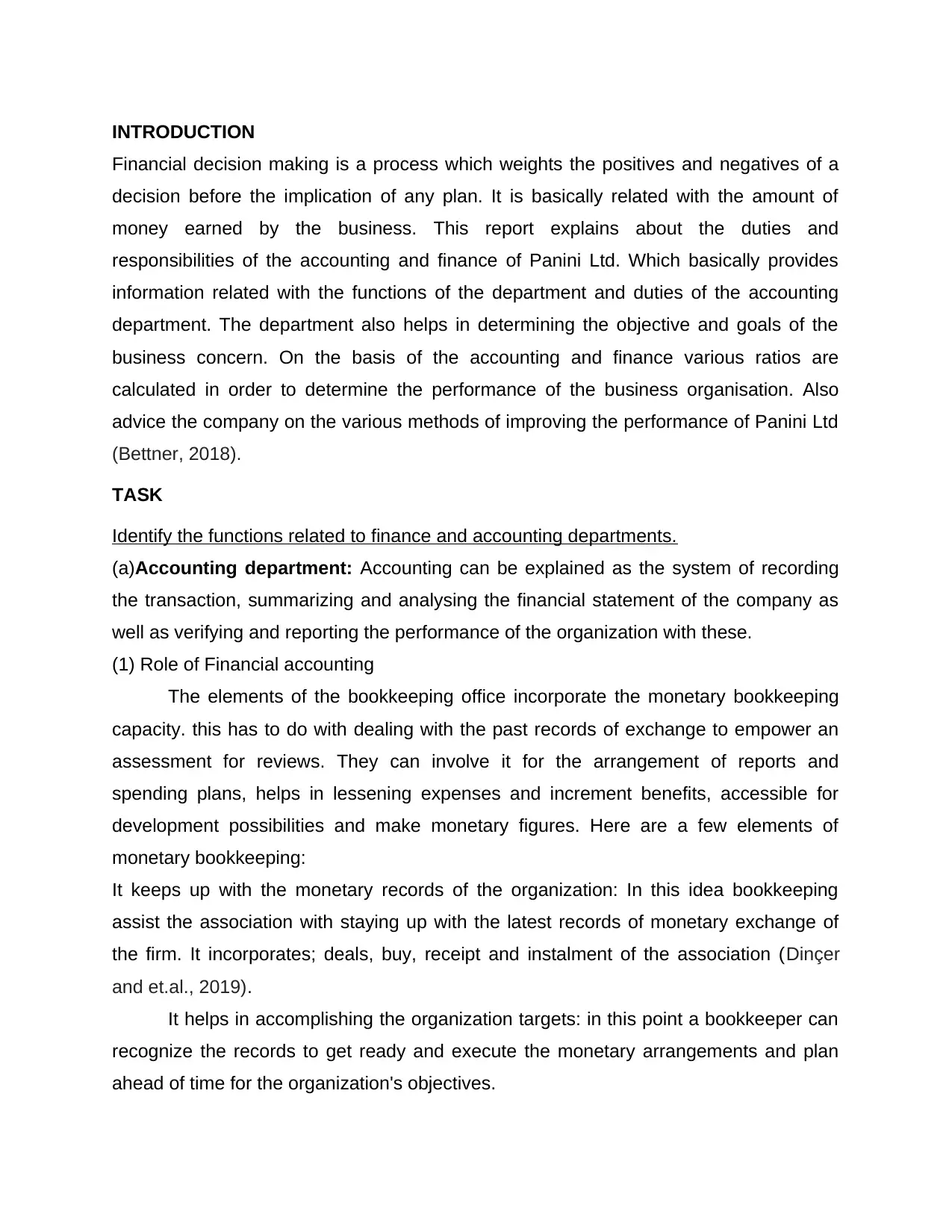
INTRODUCTION
Financial decision making is a process which weights the positives and negatives of a
decision before the implication of any plan. It is basically related with the amount of
money earned by the business. This report explains about the duties and
responsibilities of the accounting and finance of Panini Ltd. Which basically provides
information related with the functions of the department and duties of the accounting
department. The department also helps in determining the objective and goals of the
business concern. On the basis of the accounting and finance various ratios are
calculated in order to determine the performance of the business organisation. Also
advice the company on the various methods of improving the performance of Panini Ltd
(Bettner, 2018).
TASK
Identify the functions related to finance and accounting departments.
(a)Accounting department: Accounting can be explained as the system of recording
the transaction, summarizing and analysing the financial statement of the company as
well as verifying and reporting the performance of the organization with these.
(1) Role of Financial accounting
The elements of the bookkeeping office incorporate the monetary bookkeeping
capacity. this has to do with dealing with the past records of exchange to empower an
assessment for reviews. They can involve it for the arrangement of reports and
spending plans, helps in lessening expenses and increment benefits, accessible for
development possibilities and make monetary figures. Here are a few elements of
monetary bookkeeping:
It keeps up with the monetary records of the organization: In this idea bookkeeping
assist the association with staying up with the latest records of monetary exchange of
the firm. It incorporates; deals, buy, receipt and instalment of the association (Dinçer
and et.al., 2019).
It helps in accomplishing the organization targets: in this point a bookkeeper can
recognize the records to get ready and execute the monetary arrangements and plan
ahead of time for the organization's objectives.
Financial decision making is a process which weights the positives and negatives of a
decision before the implication of any plan. It is basically related with the amount of
money earned by the business. This report explains about the duties and
responsibilities of the accounting and finance of Panini Ltd. Which basically provides
information related with the functions of the department and duties of the accounting
department. The department also helps in determining the objective and goals of the
business concern. On the basis of the accounting and finance various ratios are
calculated in order to determine the performance of the business organisation. Also
advice the company on the various methods of improving the performance of Panini Ltd
(Bettner, 2018).
TASK
Identify the functions related to finance and accounting departments.
(a)Accounting department: Accounting can be explained as the system of recording
the transaction, summarizing and analysing the financial statement of the company as
well as verifying and reporting the performance of the organization with these.
(1) Role of Financial accounting
The elements of the bookkeeping office incorporate the monetary bookkeeping
capacity. this has to do with dealing with the past records of exchange to empower an
assessment for reviews. They can involve it for the arrangement of reports and
spending plans, helps in lessening expenses and increment benefits, accessible for
development possibilities and make monetary figures. Here are a few elements of
monetary bookkeeping:
It keeps up with the monetary records of the organization: In this idea bookkeeping
assist the association with staying up with the latest records of monetary exchange of
the firm. It incorporates; deals, buy, receipt and instalment of the association (Dinçer
and et.al., 2019).
It helps in accomplishing the organization targets: in this point a bookkeeper can
recognize the records to get ready and execute the monetary arrangements and plan
ahead of time for the organization's objectives.
⊘ This is a preview!⊘
Do you want full access?
Subscribe today to unlock all pages.

Trusted by 1+ million students worldwide
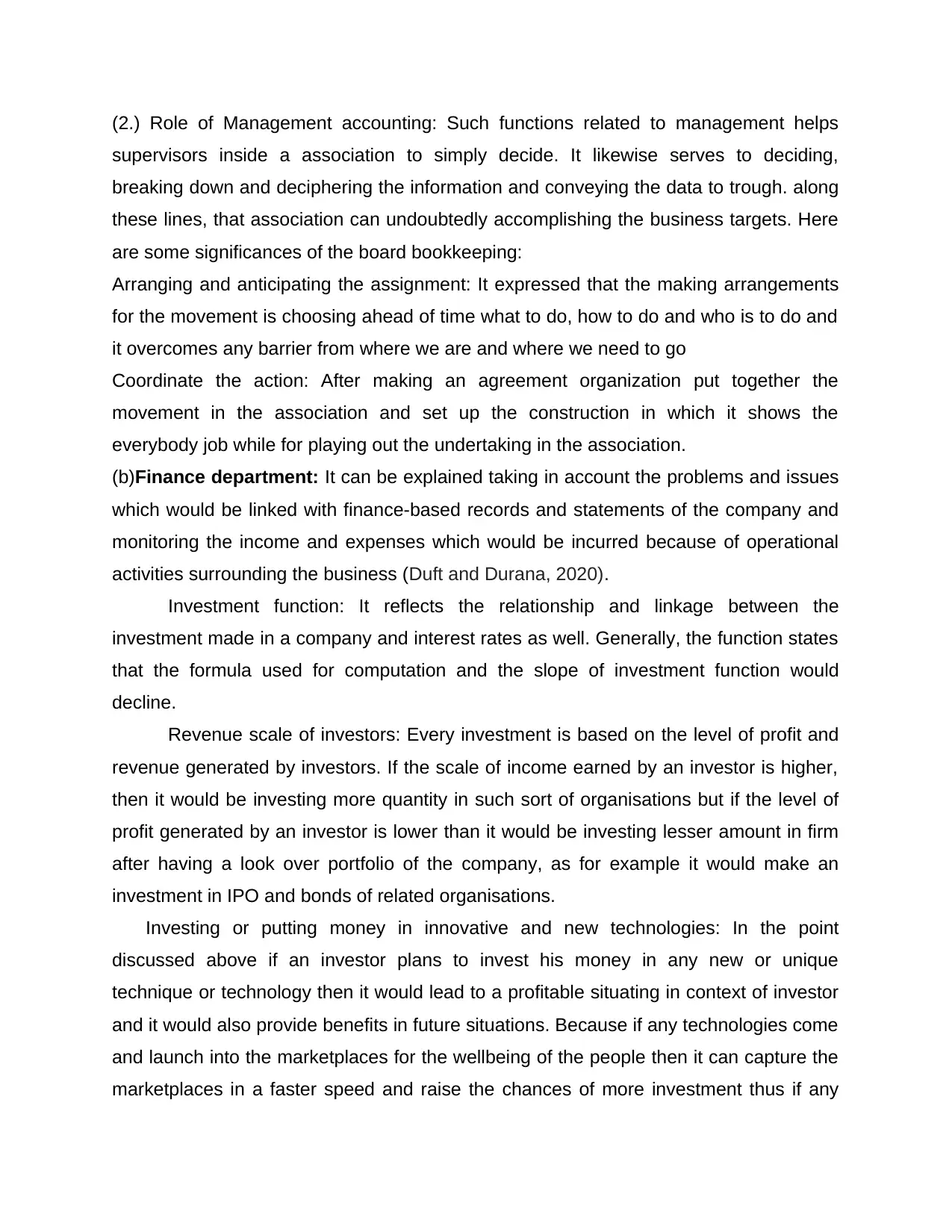
(2.) Role of Management accounting: Such functions related to management helps
supervisors inside a association to simply decide. It likewise serves to deciding,
breaking down and deciphering the information and conveying the data to trough. along
these lines, that association can undoubtedly accomplishing the business targets. Here
are some significances of the board bookkeeping:
Arranging and anticipating the assignment: It expressed that the making arrangements
for the movement is choosing ahead of time what to do, how to do and who is to do and
it overcomes any barrier from where we are and where we need to go
Coordinate the action: After making an agreement organization put together the
movement in the association and set up the construction in which it shows the
everybody job while for playing out the undertaking in the association.
(b)Finance department: It can be explained taking in account the problems and issues
which would be linked with finance-based records and statements of the company and
monitoring the income and expenses which would be incurred because of operational
activities surrounding the business (Duft and Durana, 2020).
Investment function: It reflects the relationship and linkage between the
investment made in a company and interest rates as well. Generally, the function states
that the formula used for computation and the slope of investment function would
decline.
Revenue scale of investors: Every investment is based on the level of profit and
revenue generated by investors. If the scale of income earned by an investor is higher,
then it would be investing more quantity in such sort of organisations but if the level of
profit generated by an investor is lower than it would be investing lesser amount in firm
after having a look over portfolio of the company, as for example it would make an
investment in IPO and bonds of related organisations.
Investing or putting money in innovative and new technologies: In the point
discussed above if an investor plans to invest his money in any new or unique
technique or technology then it would lead to a profitable situating in context of investor
and it would also provide benefits in future situations. Because if any technologies come
and launch into the marketplaces for the wellbeing of the people then it can capture the
marketplaces in a faster speed and raise the chances of more investment thus if any
supervisors inside a association to simply decide. It likewise serves to deciding,
breaking down and deciphering the information and conveying the data to trough. along
these lines, that association can undoubtedly accomplishing the business targets. Here
are some significances of the board bookkeeping:
Arranging and anticipating the assignment: It expressed that the making arrangements
for the movement is choosing ahead of time what to do, how to do and who is to do and
it overcomes any barrier from where we are and where we need to go
Coordinate the action: After making an agreement organization put together the
movement in the association and set up the construction in which it shows the
everybody job while for playing out the undertaking in the association.
(b)Finance department: It can be explained taking in account the problems and issues
which would be linked with finance-based records and statements of the company and
monitoring the income and expenses which would be incurred because of operational
activities surrounding the business (Duft and Durana, 2020).
Investment function: It reflects the relationship and linkage between the
investment made in a company and interest rates as well. Generally, the function states
that the formula used for computation and the slope of investment function would
decline.
Revenue scale of investors: Every investment is based on the level of profit and
revenue generated by investors. If the scale of income earned by an investor is higher,
then it would be investing more quantity in such sort of organisations but if the level of
profit generated by an investor is lower than it would be investing lesser amount in firm
after having a look over portfolio of the company, as for example it would make an
investment in IPO and bonds of related organisations.
Investing or putting money in innovative and new technologies: In the point
discussed above if an investor plans to invest his money in any new or unique
technique or technology then it would lead to a profitable situating in context of investor
and it would also provide benefits in future situations. Because if any technologies come
and launch into the marketplaces for the wellbeing of the people then it can capture the
marketplaces in a faster speed and raise the chances of more investment thus if any
Paraphrase This Document
Need a fresh take? Get an instant paraphrase of this document with our AI Paraphraser
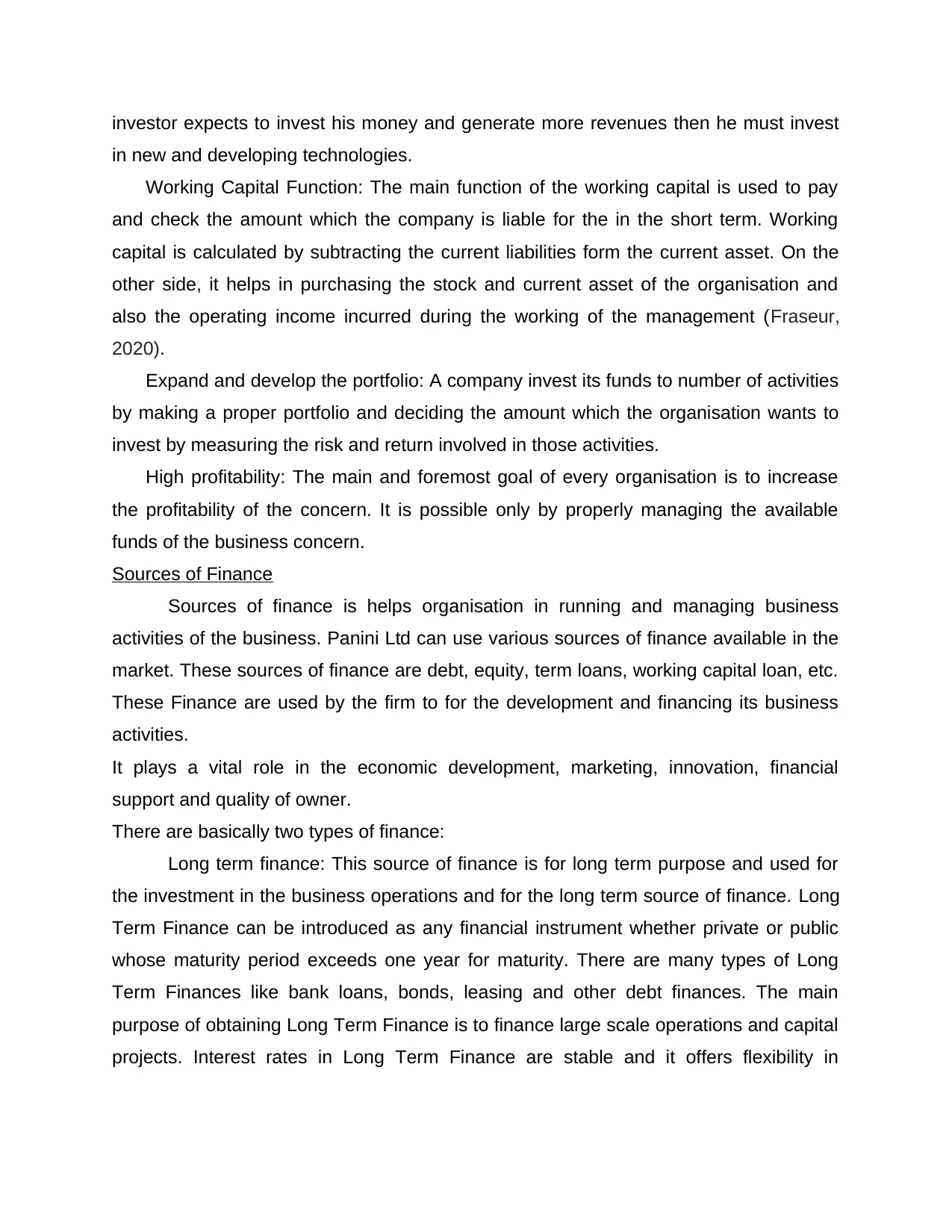
investor expects to invest his money and generate more revenues then he must invest
in new and developing technologies.
Working Capital Function: The main function of the working capital is used to pay
and check the amount which the company is liable for the in the short term. Working
capital is calculated by subtracting the current liabilities form the current asset. On the
other side, it helps in purchasing the stock and current asset of the organisation and
also the operating income incurred during the working of the management (Fraseur,
2020).
Expand and develop the portfolio: A company invest its funds to number of activities
by making a proper portfolio and deciding the amount which the organisation wants to
invest by measuring the risk and return involved in those activities.
High profitability: The main and foremost goal of every organisation is to increase
the profitability of the concern. It is possible only by properly managing the available
funds of the business concern.
Sources of Finance
Sources of finance is helps organisation in running and managing business
activities of the business. Panini Ltd can use various sources of finance available in the
market. These sources of finance are debt, equity, term loans, working capital loan, etc.
These Finance are used by the firm to for the development and financing its business
activities.
It plays a vital role in the economic development, marketing, innovation, financial
support and quality of owner.
There are basically two types of finance:
Long term finance: This source of finance is for long term purpose and used for
the investment in the business operations and for the long term source of finance. Long
Term Finance can be introduced as any financial instrument whether private or public
whose maturity period exceeds one year for maturity. There are many types of Long
Term Finances like bank loans, bonds, leasing and other debt finances. The main
purpose of obtaining Long Term Finance is to finance large scale operations and capital
projects. Interest rates in Long Term Finance are stable and it offers flexibility in
in new and developing technologies.
Working Capital Function: The main function of the working capital is used to pay
and check the amount which the company is liable for the in the short term. Working
capital is calculated by subtracting the current liabilities form the current asset. On the
other side, it helps in purchasing the stock and current asset of the organisation and
also the operating income incurred during the working of the management (Fraseur,
2020).
Expand and develop the portfolio: A company invest its funds to number of activities
by making a proper portfolio and deciding the amount which the organisation wants to
invest by measuring the risk and return involved in those activities.
High profitability: The main and foremost goal of every organisation is to increase
the profitability of the concern. It is possible only by properly managing the available
funds of the business concern.
Sources of Finance
Sources of finance is helps organisation in running and managing business
activities of the business. Panini Ltd can use various sources of finance available in the
market. These sources of finance are debt, equity, term loans, working capital loan, etc.
These Finance are used by the firm to for the development and financing its business
activities.
It plays a vital role in the economic development, marketing, innovation, financial
support and quality of owner.
There are basically two types of finance:
Long term finance: This source of finance is for long term purpose and used for
the investment in the business operations and for the long term source of finance. Long
Term Finance can be introduced as any financial instrument whether private or public
whose maturity period exceeds one year for maturity. There are many types of Long
Term Finances like bank loans, bonds, leasing and other debt finances. The main
purpose of obtaining Long Term Finance is to finance large scale operations and capital
projects. Interest rates in Long Term Finance are stable and it offers flexibility in
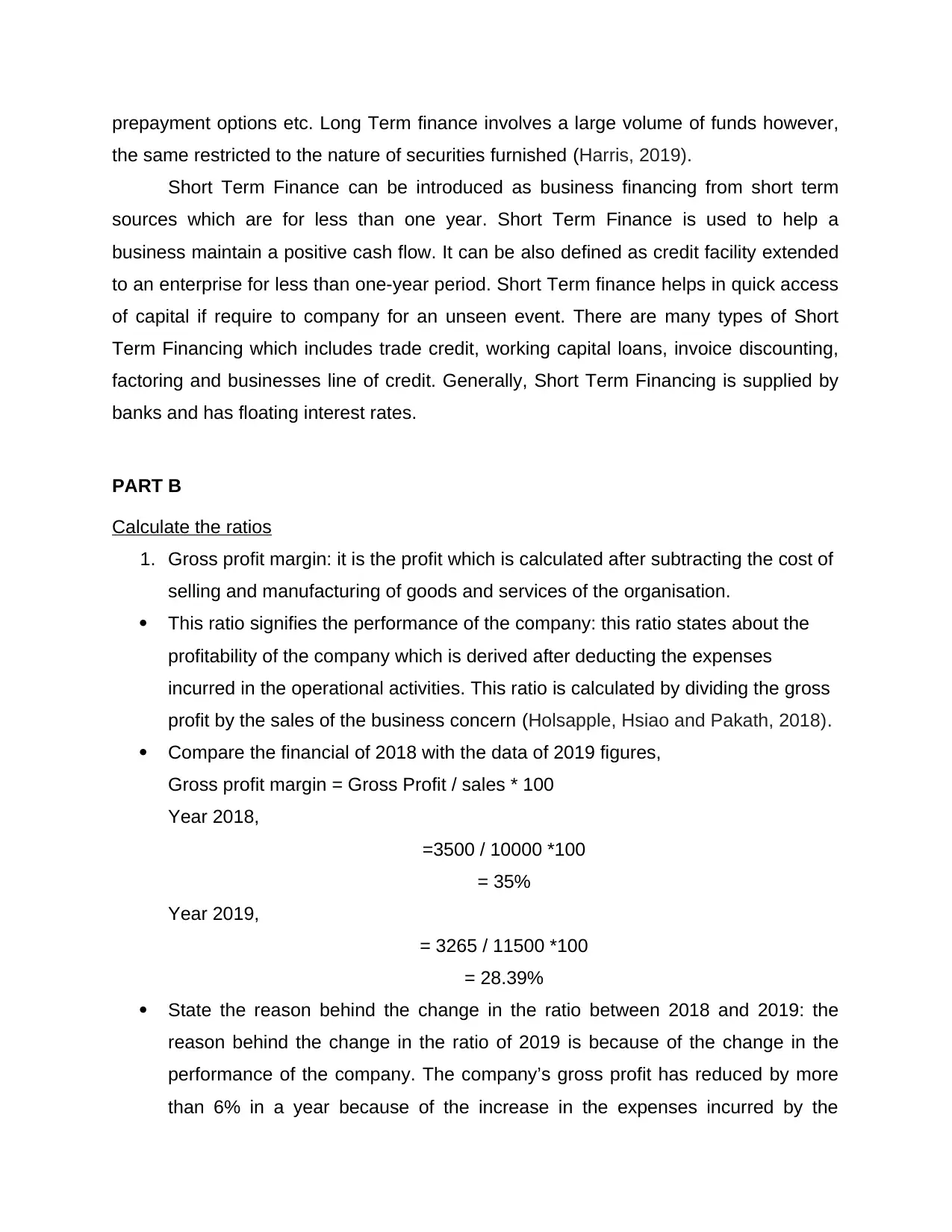
prepayment options etc. Long Term finance involves a large volume of funds however,
the same restricted to the nature of securities furnished (Harris, 2019).
Short Term Finance can be introduced as business financing from short term
sources which are for less than one year. Short Term Finance is used to help a
business maintain a positive cash flow. It can be also defined as credit facility extended
to an enterprise for less than one-year period. Short Term finance helps in quick access
of capital if require to company for an unseen event. There are many types of Short
Term Financing which includes trade credit, working capital loans, invoice discounting,
factoring and businesses line of credit. Generally, Short Term Financing is supplied by
banks and has floating interest rates.
PART B
Calculate the ratios
1. Gross profit margin: it is the profit which is calculated after subtracting the cost of
selling and manufacturing of goods and services of the organisation.
This ratio signifies the performance of the company: this ratio states about the
profitability of the company which is derived after deducting the expenses
incurred in the operational activities. This ratio is calculated by dividing the gross
profit by the sales of the business concern (Holsapple, Hsiao and Pakath, 2018).
Compare the financial of 2018 with the data of 2019 figures,
Gross profit margin = Gross Profit / sales * 100
Year 2018,
=3500 / 10000 *100
= 35%
Year 2019,
= 3265 / 11500 *100
= 28.39%
State the reason behind the change in the ratio between 2018 and 2019: the
reason behind the change in the ratio of 2019 is because of the change in the
performance of the company. The company’s gross profit has reduced by more
than 6% in a year because of the increase in the expenses incurred by the
the same restricted to the nature of securities furnished (Harris, 2019).
Short Term Finance can be introduced as business financing from short term
sources which are for less than one year. Short Term Finance is used to help a
business maintain a positive cash flow. It can be also defined as credit facility extended
to an enterprise for less than one-year period. Short Term finance helps in quick access
of capital if require to company for an unseen event. There are many types of Short
Term Financing which includes trade credit, working capital loans, invoice discounting,
factoring and businesses line of credit. Generally, Short Term Financing is supplied by
banks and has floating interest rates.
PART B
Calculate the ratios
1. Gross profit margin: it is the profit which is calculated after subtracting the cost of
selling and manufacturing of goods and services of the organisation.
This ratio signifies the performance of the company: this ratio states about the
profitability of the company which is derived after deducting the expenses
incurred in the operational activities. This ratio is calculated by dividing the gross
profit by the sales of the business concern (Holsapple, Hsiao and Pakath, 2018).
Compare the financial of 2018 with the data of 2019 figures,
Gross profit margin = Gross Profit / sales * 100
Year 2018,
=3500 / 10000 *100
= 35%
Year 2019,
= 3265 / 11500 *100
= 28.39%
State the reason behind the change in the ratio between 2018 and 2019: the
reason behind the change in the ratio of 2019 is because of the change in the
performance of the company. The company’s gross profit has reduced by more
than 6% in a year because of the increase in the expenses incurred by the
⊘ This is a preview!⊘
Do you want full access?
Subscribe today to unlock all pages.

Trusted by 1+ million students worldwide
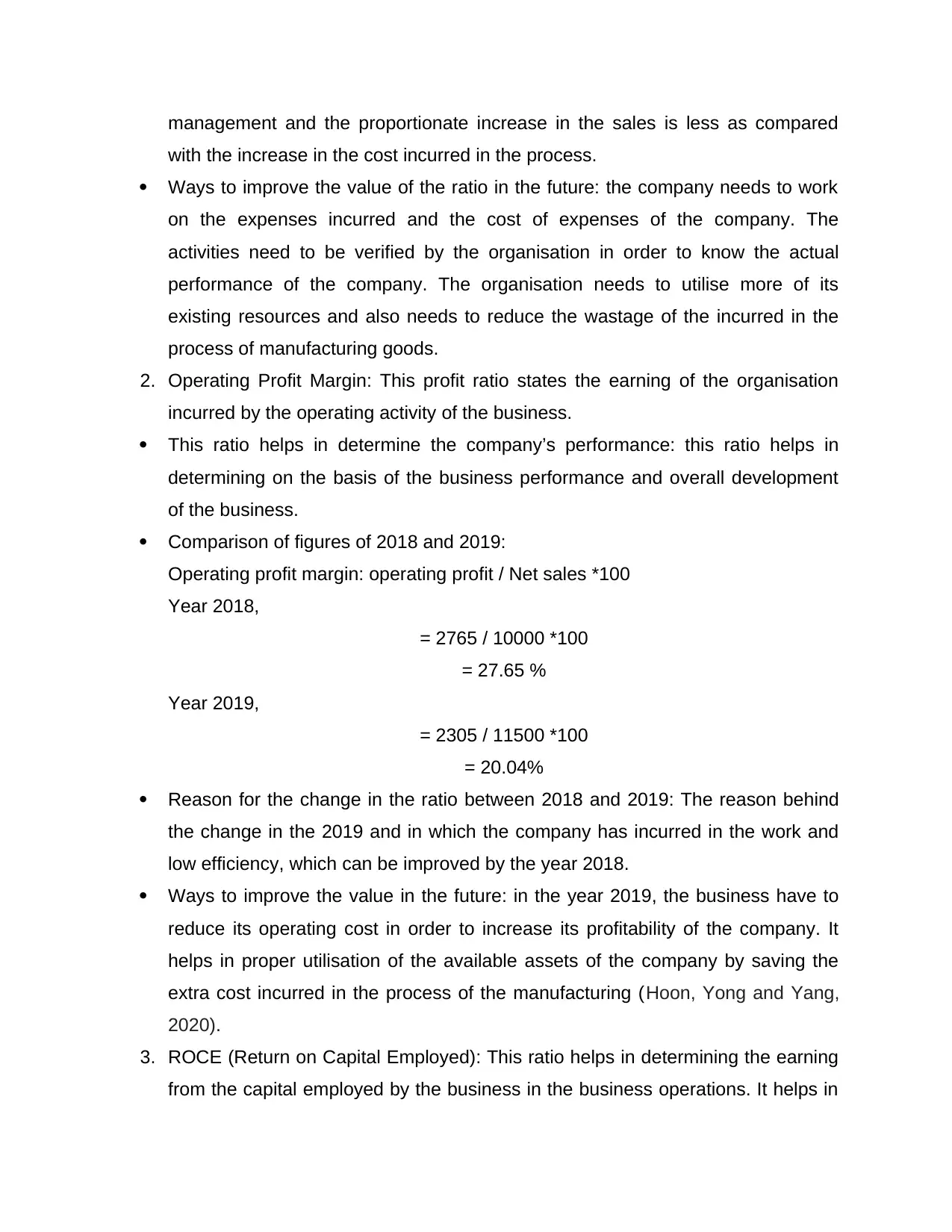
management and the proportionate increase in the sales is less as compared
with the increase in the cost incurred in the process.
Ways to improve the value of the ratio in the future: the company needs to work
on the expenses incurred and the cost of expenses of the company. The
activities need to be verified by the organisation in order to know the actual
performance of the company. The organisation needs to utilise more of its
existing resources and also needs to reduce the wastage of the incurred in the
process of manufacturing goods.
2. Operating Profit Margin: This profit ratio states the earning of the organisation
incurred by the operating activity of the business.
This ratio helps in determine the company’s performance: this ratio helps in
determining on the basis of the business performance and overall development
of the business.
Comparison of figures of 2018 and 2019:
Operating profit margin: operating profit / Net sales *100
Year 2018,
= 2765 / 10000 *100
= 27.65 %
Year 2019,
= 2305 / 11500 *100
= 20.04%
Reason for the change in the ratio between 2018 and 2019: The reason behind
the change in the 2019 and in which the company has incurred in the work and
low efficiency, which can be improved by the year 2018.
Ways to improve the value in the future: in the year 2019, the business have to
reduce its operating cost in order to increase its profitability of the company. It
helps in proper utilisation of the available assets of the company by saving the
extra cost incurred in the process of the manufacturing (Hoon, Yong and Yang,
2020).
3. ROCE (Return on Capital Employed): This ratio helps in determining the earning
from the capital employed by the business in the business operations. It helps in
with the increase in the cost incurred in the process.
Ways to improve the value of the ratio in the future: the company needs to work
on the expenses incurred and the cost of expenses of the company. The
activities need to be verified by the organisation in order to know the actual
performance of the company. The organisation needs to utilise more of its
existing resources and also needs to reduce the wastage of the incurred in the
process of manufacturing goods.
2. Operating Profit Margin: This profit ratio states the earning of the organisation
incurred by the operating activity of the business.
This ratio helps in determine the company’s performance: this ratio helps in
determining on the basis of the business performance and overall development
of the business.
Comparison of figures of 2018 and 2019:
Operating profit margin: operating profit / Net sales *100
Year 2018,
= 2765 / 10000 *100
= 27.65 %
Year 2019,
= 2305 / 11500 *100
= 20.04%
Reason for the change in the ratio between 2018 and 2019: The reason behind
the change in the 2019 and in which the company has incurred in the work and
low efficiency, which can be improved by the year 2018.
Ways to improve the value in the future: in the year 2019, the business have to
reduce its operating cost in order to increase its profitability of the company. It
helps in proper utilisation of the available assets of the company by saving the
extra cost incurred in the process of the manufacturing (Hoon, Yong and Yang,
2020).
3. ROCE (Return on Capital Employed): This ratio helps in determining the earning
from the capital employed by the business in the business operations. It helps in
Paraphrase This Document
Need a fresh take? Get an instant paraphrase of this document with our AI Paraphraser
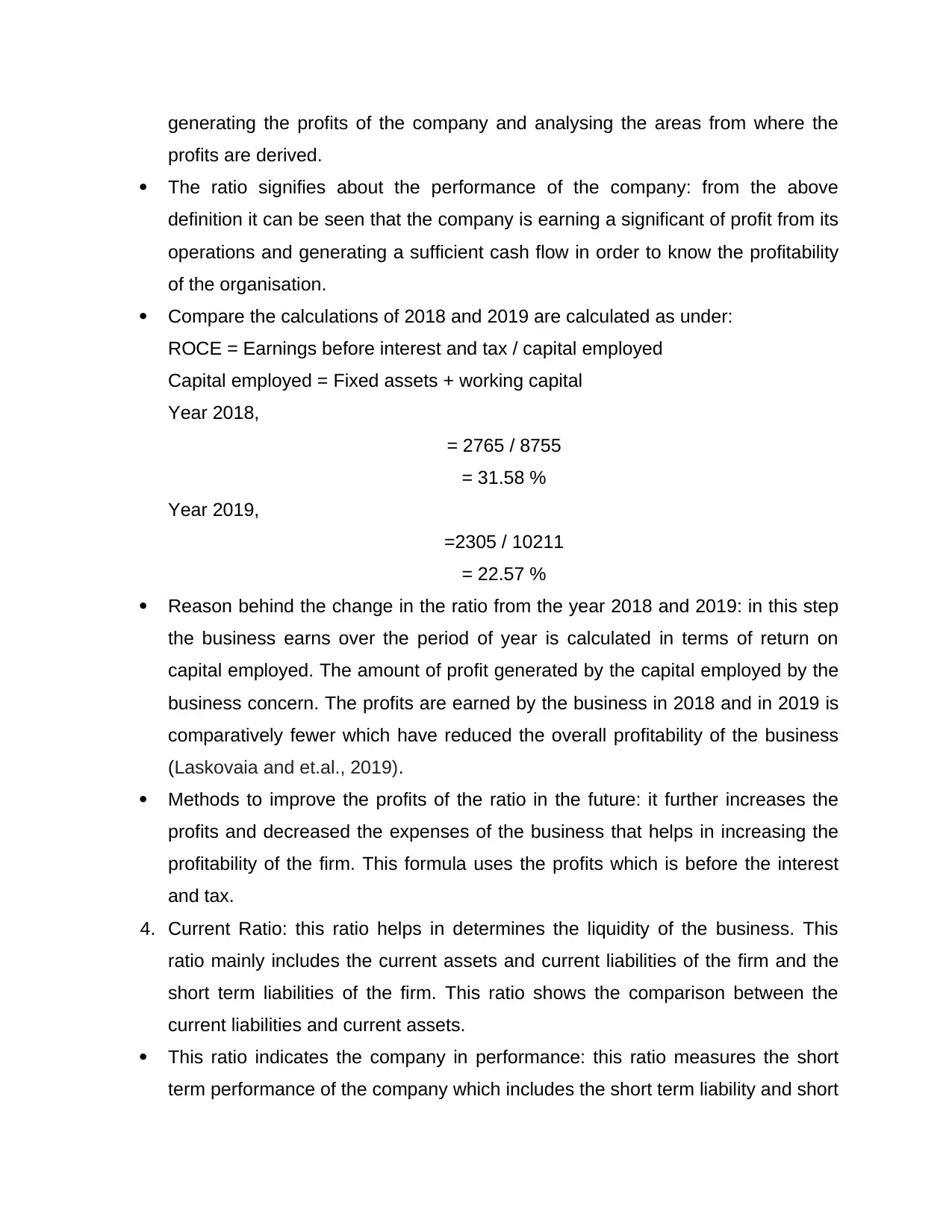
generating the profits of the company and analysing the areas from where the
profits are derived.
The ratio signifies about the performance of the company: from the above
definition it can be seen that the company is earning a significant of profit from its
operations and generating a sufficient cash flow in order to know the profitability
of the organisation.
Compare the calculations of 2018 and 2019 are calculated as under:
ROCE = Earnings before interest and tax / capital employed
Capital employed = Fixed assets + working capital
Year 2018,
= 2765 / 8755
= 31.58 %
Year 2019,
=2305 / 10211
= 22.57 %
Reason behind the change in the ratio from the year 2018 and 2019: in this step
the business earns over the period of year is calculated in terms of return on
capital employed. The amount of profit generated by the capital employed by the
business concern. The profits are earned by the business in 2018 and in 2019 is
comparatively fewer which have reduced the overall profitability of the business
(Laskovaia and et.al., 2019).
Methods to improve the profits of the ratio in the future: it further increases the
profits and decreased the expenses of the business that helps in increasing the
profitability of the firm. This formula uses the profits which is before the interest
and tax.
4. Current Ratio: this ratio helps in determines the liquidity of the business. This
ratio mainly includes the current assets and current liabilities of the firm and the
short term liabilities of the firm. This ratio shows the comparison between the
current liabilities and current assets.
This ratio indicates the company in performance: this ratio measures the short
term performance of the company which includes the short term liability and short
profits are derived.
The ratio signifies about the performance of the company: from the above
definition it can be seen that the company is earning a significant of profit from its
operations and generating a sufficient cash flow in order to know the profitability
of the organisation.
Compare the calculations of 2018 and 2019 are calculated as under:
ROCE = Earnings before interest and tax / capital employed
Capital employed = Fixed assets + working capital
Year 2018,
= 2765 / 8755
= 31.58 %
Year 2019,
=2305 / 10211
= 22.57 %
Reason behind the change in the ratio from the year 2018 and 2019: in this step
the business earns over the period of year is calculated in terms of return on
capital employed. The amount of profit generated by the capital employed by the
business concern. The profits are earned by the business in 2018 and in 2019 is
comparatively fewer which have reduced the overall profitability of the business
(Laskovaia and et.al., 2019).
Methods to improve the profits of the ratio in the future: it further increases the
profits and decreased the expenses of the business that helps in increasing the
profitability of the firm. This formula uses the profits which is before the interest
and tax.
4. Current Ratio: this ratio helps in determines the liquidity of the business. This
ratio mainly includes the current assets and current liabilities of the firm and the
short term liabilities of the firm. This ratio shows the comparison between the
current liabilities and current assets.
This ratio indicates the company in performance: this ratio measures the short
term performance of the company which includes the short term liability and short
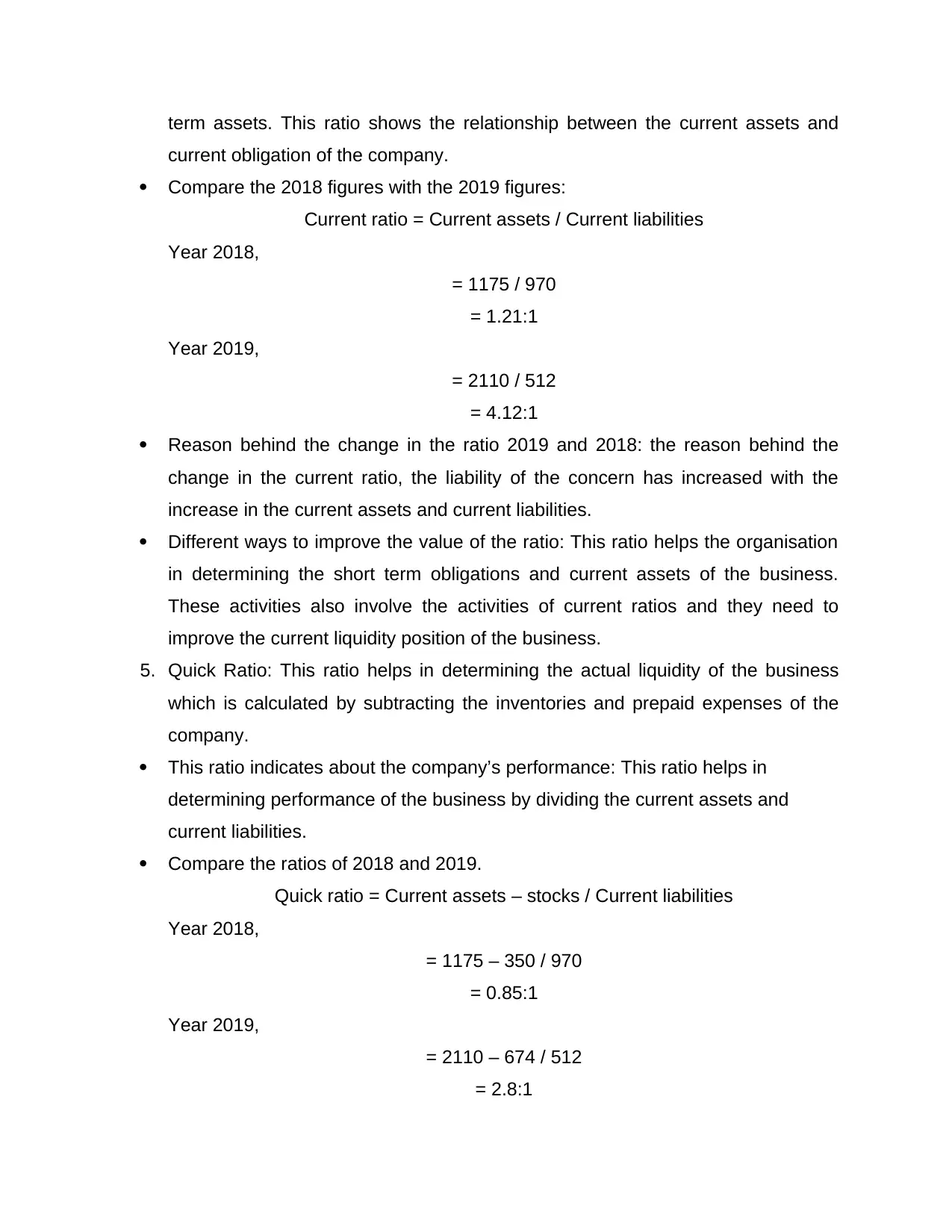
term assets. This ratio shows the relationship between the current assets and
current obligation of the company.
Compare the 2018 figures with the 2019 figures:
Current ratio = Current assets / Current liabilities
Year 2018,
= 1175 / 970
= 1.21:1
Year 2019,
= 2110 / 512
= 4.12:1
Reason behind the change in the ratio 2019 and 2018: the reason behind the
change in the current ratio, the liability of the concern has increased with the
increase in the current assets and current liabilities.
Different ways to improve the value of the ratio: This ratio helps the organisation
in determining the short term obligations and current assets of the business.
These activities also involve the activities of current ratios and they need to
improve the current liquidity position of the business.
5. Quick Ratio: This ratio helps in determining the actual liquidity of the business
which is calculated by subtracting the inventories and prepaid expenses of the
company.
This ratio indicates about the company’s performance: This ratio helps in
determining performance of the business by dividing the current assets and
current liabilities.
Compare the ratios of 2018 and 2019.
Quick ratio = Current assets – stocks / Current liabilities
Year 2018,
= 1175 – 350 / 970
= 0.85:1
Year 2019,
= 2110 – 674 / 512
= 2.8:1
current obligation of the company.
Compare the 2018 figures with the 2019 figures:
Current ratio = Current assets / Current liabilities
Year 2018,
= 1175 / 970
= 1.21:1
Year 2019,
= 2110 / 512
= 4.12:1
Reason behind the change in the ratio 2019 and 2018: the reason behind the
change in the current ratio, the liability of the concern has increased with the
increase in the current assets and current liabilities.
Different ways to improve the value of the ratio: This ratio helps the organisation
in determining the short term obligations and current assets of the business.
These activities also involve the activities of current ratios and they need to
improve the current liquidity position of the business.
5. Quick Ratio: This ratio helps in determining the actual liquidity of the business
which is calculated by subtracting the inventories and prepaid expenses of the
company.
This ratio indicates about the company’s performance: This ratio helps in
determining performance of the business by dividing the current assets and
current liabilities.
Compare the ratios of 2018 and 2019.
Quick ratio = Current assets – stocks / Current liabilities
Year 2018,
= 1175 – 350 / 970
= 0.85:1
Year 2019,
= 2110 – 674 / 512
= 2.8:1
⊘ This is a preview!⊘
Do you want full access?
Subscribe today to unlock all pages.

Trusted by 1+ million students worldwide
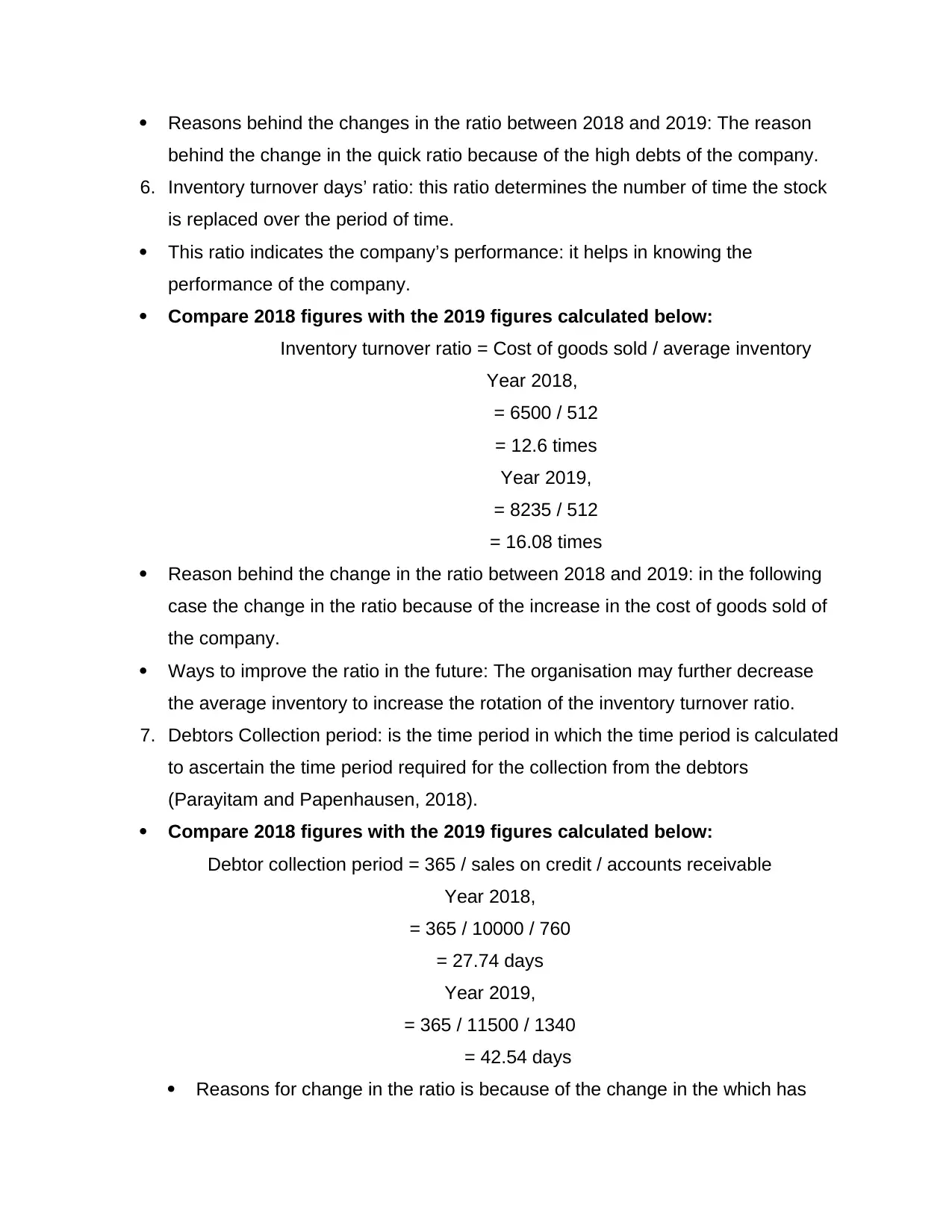
Reasons behind the changes in the ratio between 2018 and 2019: The reason
behind the change in the quick ratio because of the high debts of the company.
6. Inventory turnover days’ ratio: this ratio determines the number of time the stock
is replaced over the period of time.
This ratio indicates the company’s performance: it helps in knowing the
performance of the company.
Compare 2018 figures with the 2019 figures calculated below:
Inventory turnover ratio = Cost of goods sold / average inventory
Year 2018,
= 6500 / 512
= 12.6 times
Year 2019,
= 8235 / 512
= 16.08 times
Reason behind the change in the ratio between 2018 and 2019: in the following
case the change in the ratio because of the increase in the cost of goods sold of
the company.
Ways to improve the ratio in the future: The organisation may further decrease
the average inventory to increase the rotation of the inventory turnover ratio.
7. Debtors Collection period: is the time period in which the time period is calculated
to ascertain the time period required for the collection from the debtors
(Parayitam and Papenhausen, 2018).
Compare 2018 figures with the 2019 figures calculated below:
Debtor collection period = 365 / sales on credit / accounts receivable
Year 2018,
= 365 / 10000 / 760
= 27.74 days
Year 2019,
= 365 / 11500 / 1340
= 42.54 days
Reasons for change in the ratio is because of the change in the which has
behind the change in the quick ratio because of the high debts of the company.
6. Inventory turnover days’ ratio: this ratio determines the number of time the stock
is replaced over the period of time.
This ratio indicates the company’s performance: it helps in knowing the
performance of the company.
Compare 2018 figures with the 2019 figures calculated below:
Inventory turnover ratio = Cost of goods sold / average inventory
Year 2018,
= 6500 / 512
= 12.6 times
Year 2019,
= 8235 / 512
= 16.08 times
Reason behind the change in the ratio between 2018 and 2019: in the following
case the change in the ratio because of the increase in the cost of goods sold of
the company.
Ways to improve the ratio in the future: The organisation may further decrease
the average inventory to increase the rotation of the inventory turnover ratio.
7. Debtors Collection period: is the time period in which the time period is calculated
to ascertain the time period required for the collection from the debtors
(Parayitam and Papenhausen, 2018).
Compare 2018 figures with the 2019 figures calculated below:
Debtor collection period = 365 / sales on credit / accounts receivable
Year 2018,
= 365 / 10000 / 760
= 27.74 days
Year 2019,
= 365 / 11500 / 1340
= 42.54 days
Reasons for change in the ratio is because of the change in the which has
Paraphrase This Document
Need a fresh take? Get an instant paraphrase of this document with our AI Paraphraser
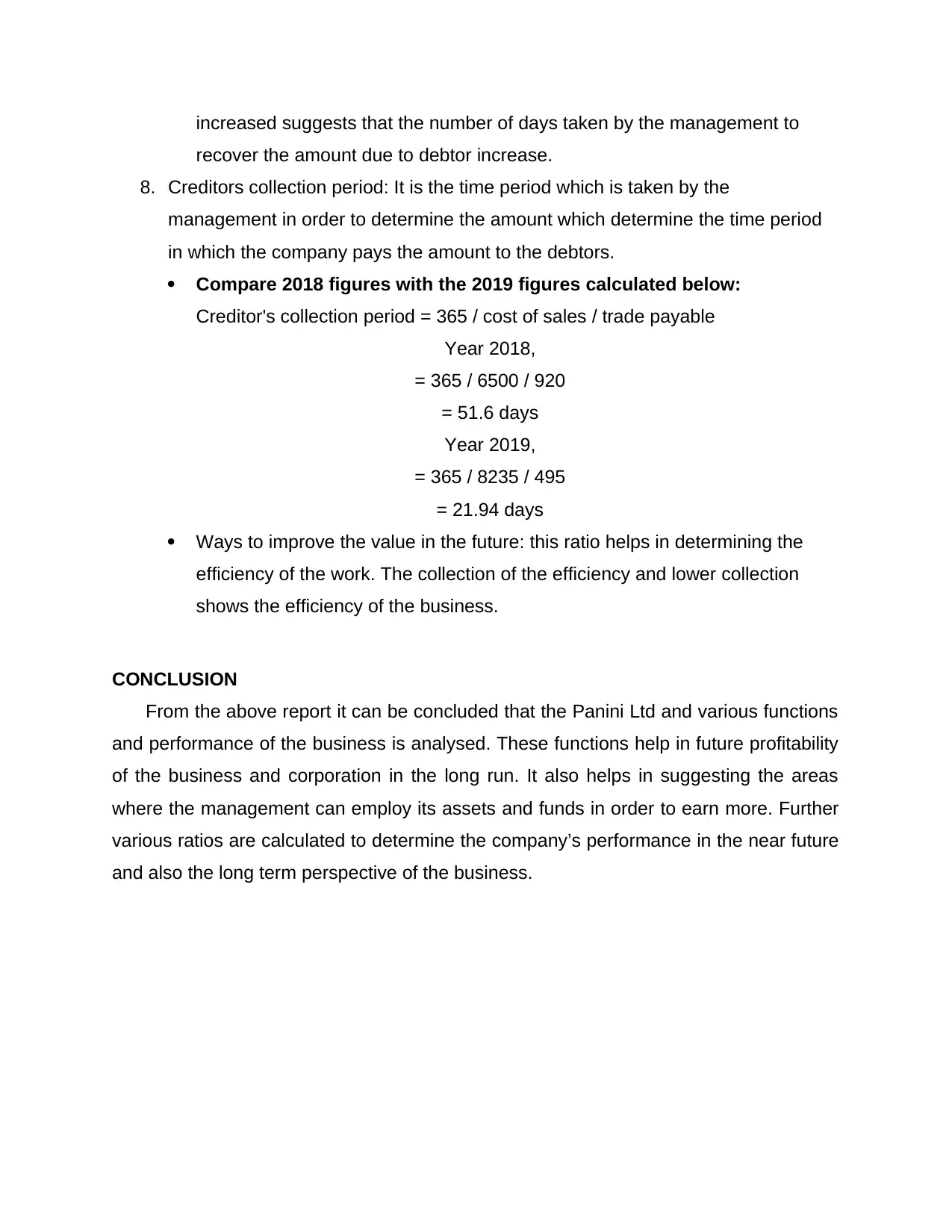
increased suggests that the number of days taken by the management to
recover the amount due to debtor increase.
8. Creditors collection period: It is the time period which is taken by the
management in order to determine the amount which determine the time period
in which the company pays the amount to the debtors.
Compare 2018 figures with the 2019 figures calculated below:
Creditor's collection period = 365 / cost of sales / trade payable
Year 2018,
= 365 / 6500 / 920
= 51.6 days
Year 2019,
= 365 / 8235 / 495
= 21.94 days
Ways to improve the value in the future: this ratio helps in determining the
efficiency of the work. The collection of the efficiency and lower collection
shows the efficiency of the business.
CONCLUSION
From the above report it can be concluded that the Panini Ltd and various functions
and performance of the business is analysed. These functions help in future profitability
of the business and corporation in the long run. It also helps in suggesting the areas
where the management can employ its assets and funds in order to earn more. Further
various ratios are calculated to determine the company’s performance in the near future
and also the long term perspective of the business.
recover the amount due to debtor increase.
8. Creditors collection period: It is the time period which is taken by the
management in order to determine the amount which determine the time period
in which the company pays the amount to the debtors.
Compare 2018 figures with the 2019 figures calculated below:
Creditor's collection period = 365 / cost of sales / trade payable
Year 2018,
= 365 / 6500 / 920
= 51.6 days
Year 2019,
= 365 / 8235 / 495
= 21.94 days
Ways to improve the value in the future: this ratio helps in determining the
efficiency of the work. The collection of the efficiency and lower collection
shows the efficiency of the business.
CONCLUSION
From the above report it can be concluded that the Panini Ltd and various functions
and performance of the business is analysed. These functions help in future profitability
of the business and corporation in the long run. It also helps in suggesting the areas
where the management can employ its assets and funds in order to earn more. Further
various ratios are calculated to determine the company’s performance in the near future
and also the long term perspective of the business.
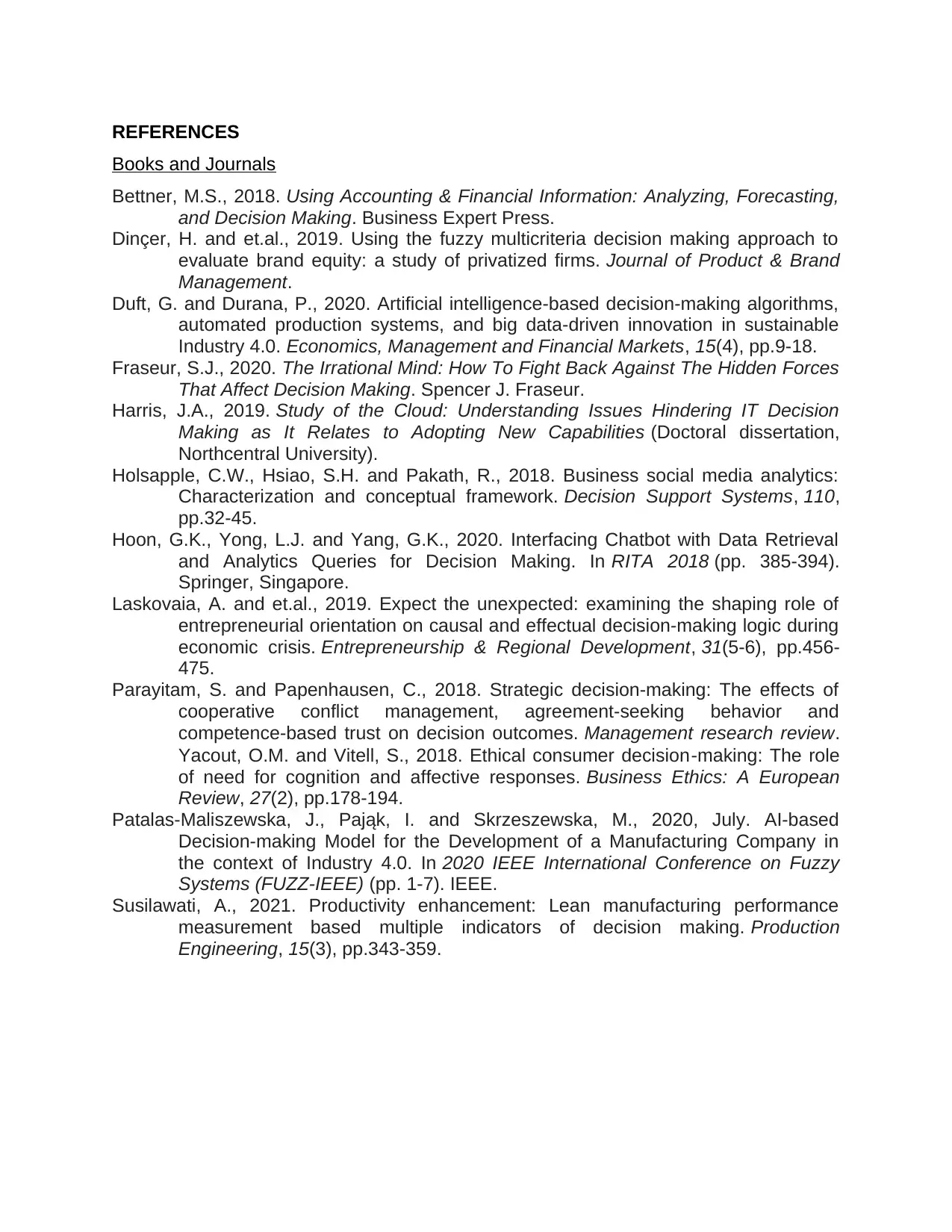
REFERENCES
Books and Journals
Bettner, M.S., 2018. Using Accounting & Financial Information: Analyzing, Forecasting,
and Decision Making. Business Expert Press.
Dinçer, H. and et.al., 2019. Using the fuzzy multicriteria decision making approach to
evaluate brand equity: a study of privatized firms. Journal of Product & Brand
Management.
Duft, G. and Durana, P., 2020. Artificial intelligence-based decision-making algorithms,
automated production systems, and big data-driven innovation in sustainable
Industry 4.0. Economics, Management and Financial Markets, 15(4), pp.9-18.
Fraseur, S.J., 2020. The Irrational Mind: How To Fight Back Against The Hidden Forces
That Affect Decision Making. Spencer J. Fraseur.
Harris, J.A., 2019. Study of the Cloud: Understanding Issues Hindering IT Decision
Making as It Relates to Adopting New Capabilities (Doctoral dissertation,
Northcentral University).
Holsapple, C.W., Hsiao, S.H. and Pakath, R., 2018. Business social media analytics:
Characterization and conceptual framework. Decision Support Systems, 110,
pp.32-45.
Hoon, G.K., Yong, L.J. and Yang, G.K., 2020. Interfacing Chatbot with Data Retrieval
and Analytics Queries for Decision Making. In RITA 2018 (pp. 385-394).
Springer, Singapore.
Laskovaia, A. and et.al., 2019. Expect the unexpected: examining the shaping role of
entrepreneurial orientation on causal and effectual decision-making logic during
economic crisis. Entrepreneurship & Regional Development, 31(5-6), pp.456-
475.
Parayitam, S. and Papenhausen, C., 2018. Strategic decision-making: The effects of
cooperative conflict management, agreement-seeking behavior and
competence-based trust on decision outcomes. Management research review.
Yacout, O.M. and Vitell, S., 2018. Ethical consumer decision‐making: The role
of need for cognition and affective responses. Business Ethics: A European
Review, 27(2), pp.178-194.
Patalas-Maliszewska, J., Pająk, I. and Skrzeszewska, M., 2020, July. AI-based
Decision-making Model for the Development of a Manufacturing Company in
the context of Industry 4.0. In 2020 IEEE International Conference on Fuzzy
Systems (FUZZ-IEEE) (pp. 1-7). IEEE.
Susilawati, A., 2021. Productivity enhancement: Lean manufacturing performance
measurement based multiple indicators of decision making. Production
Engineering, 15(3), pp.343-359.
Books and Journals
Bettner, M.S., 2018. Using Accounting & Financial Information: Analyzing, Forecasting,
and Decision Making. Business Expert Press.
Dinçer, H. and et.al., 2019. Using the fuzzy multicriteria decision making approach to
evaluate brand equity: a study of privatized firms. Journal of Product & Brand
Management.
Duft, G. and Durana, P., 2020. Artificial intelligence-based decision-making algorithms,
automated production systems, and big data-driven innovation in sustainable
Industry 4.0. Economics, Management and Financial Markets, 15(4), pp.9-18.
Fraseur, S.J., 2020. The Irrational Mind: How To Fight Back Against The Hidden Forces
That Affect Decision Making. Spencer J. Fraseur.
Harris, J.A., 2019. Study of the Cloud: Understanding Issues Hindering IT Decision
Making as It Relates to Adopting New Capabilities (Doctoral dissertation,
Northcentral University).
Holsapple, C.W., Hsiao, S.H. and Pakath, R., 2018. Business social media analytics:
Characterization and conceptual framework. Decision Support Systems, 110,
pp.32-45.
Hoon, G.K., Yong, L.J. and Yang, G.K., 2020. Interfacing Chatbot with Data Retrieval
and Analytics Queries for Decision Making. In RITA 2018 (pp. 385-394).
Springer, Singapore.
Laskovaia, A. and et.al., 2019. Expect the unexpected: examining the shaping role of
entrepreneurial orientation on causal and effectual decision-making logic during
economic crisis. Entrepreneurship & Regional Development, 31(5-6), pp.456-
475.
Parayitam, S. and Papenhausen, C., 2018. Strategic decision-making: The effects of
cooperative conflict management, agreement-seeking behavior and
competence-based trust on decision outcomes. Management research review.
Yacout, O.M. and Vitell, S., 2018. Ethical consumer decision‐making: The role
of need for cognition and affective responses. Business Ethics: A European
Review, 27(2), pp.178-194.
Patalas-Maliszewska, J., Pająk, I. and Skrzeszewska, M., 2020, July. AI-based
Decision-making Model for the Development of a Manufacturing Company in
the context of Industry 4.0. In 2020 IEEE International Conference on Fuzzy
Systems (FUZZ-IEEE) (pp. 1-7). IEEE.
Susilawati, A., 2021. Productivity enhancement: Lean manufacturing performance
measurement based multiple indicators of decision making. Production
Engineering, 15(3), pp.343-359.
⊘ This is a preview!⊘
Do you want full access?
Subscribe today to unlock all pages.

Trusted by 1+ million students worldwide
1 out of 12
Related Documents
Your All-in-One AI-Powered Toolkit for Academic Success.
+13062052269
info@desklib.com
Available 24*7 on WhatsApp / Email
![[object Object]](/_next/static/media/star-bottom.7253800d.svg)
Unlock your academic potential
Copyright © 2020–2025 A2Z Services. All Rights Reserved. Developed and managed by ZUCOL.
